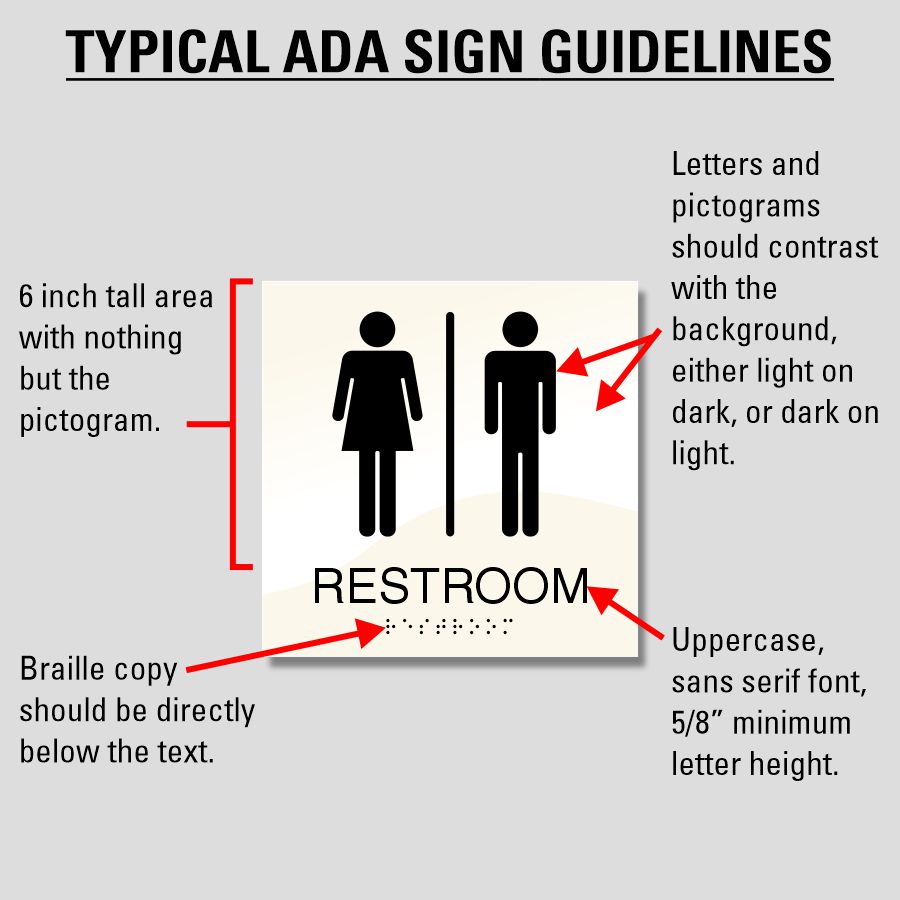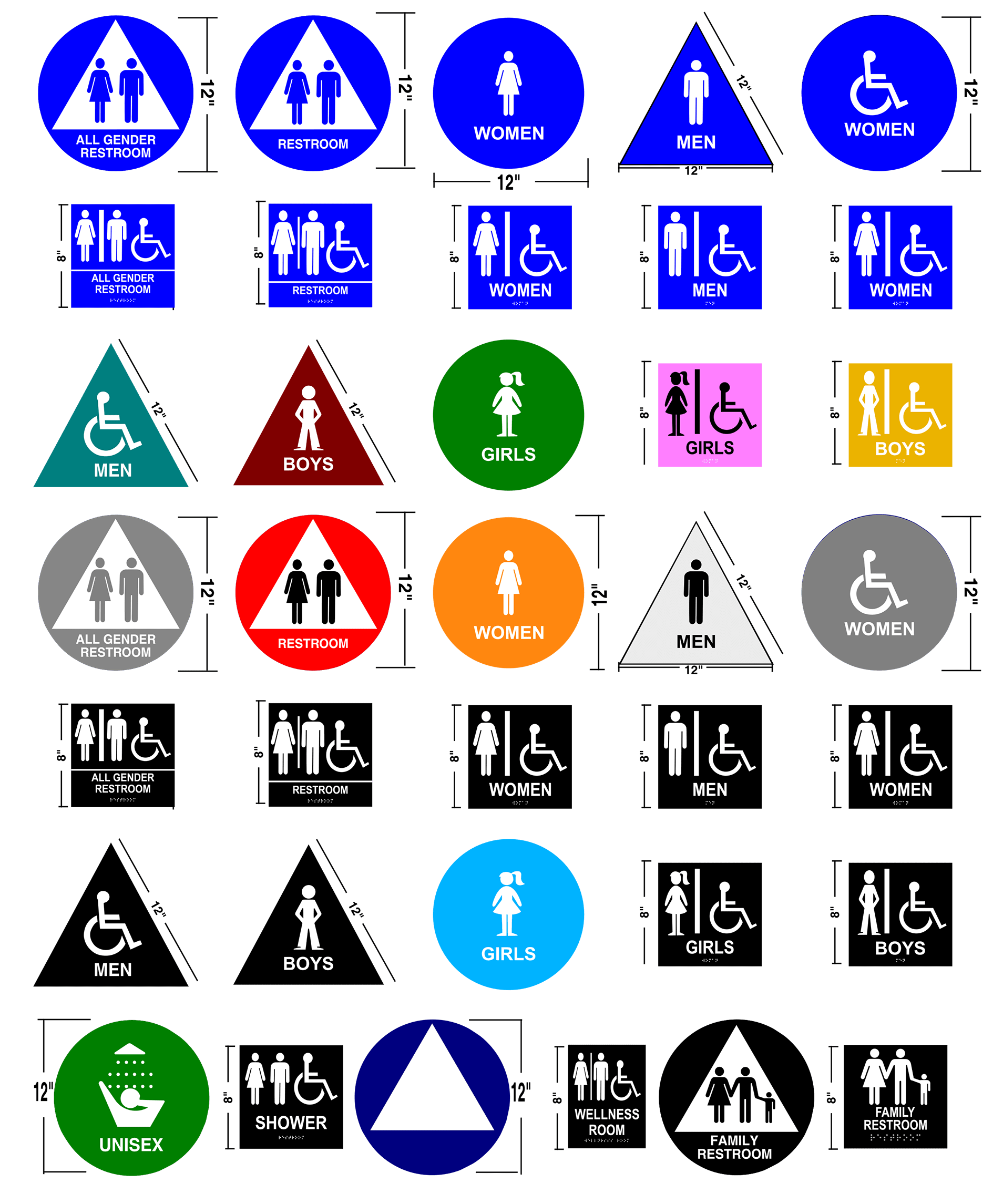Exactly How ADA Signs Improve Access for Everyone
Exactly How ADA Signs Improve Access for Everyone
Blog Article
Discovering the Trick Attributes of ADA Indicators for Boosted Access
In the realm of access, ADA indicators serve as quiet yet powerful allies, ensuring that areas are navigable and inclusive for people with impairments. By incorporating Braille and tactile aspects, these signs damage barriers for the visually damaged, while high-contrast shade plans and legible font styles provide to varied visual demands.
Significance of ADA Conformity
Making certain compliance with the Americans with Disabilities Act (ADA) is crucial for cultivating inclusivity and equal access in public rooms and workplaces. The ADA, enacted in 1990, mandates that all public facilities, employers, and transportation solutions accommodate people with handicaps, guaranteeing they enjoy the same legal rights and opportunities as others. Compliance with ADA requirements not only satisfies lawful obligations however additionally boosts a company's track record by showing its dedication to variety and inclusivity.
One of the crucial elements of ADA compliance is the execution of accessible signs. ADA indicators are created to guarantee that people with disabilities can quickly browse with structures and rooms.
Moreover, sticking to ADA guidelines can alleviate the danger of legal effects and prospective penalties. Organizations that fall short to conform with ADA guidelines may encounter claims or penalties, which can be both financially burdensome and destructive to their public photo. Therefore, ADA conformity is essential to cultivating an equitable environment for every person.
Braille and Tactile Elements
The incorporation of Braille and tactile aspects right into ADA signage embodies the principles of access and inclusivity. It is typically placed below the corresponding text on signs to guarantee that individuals can access the information without visual support.
Tactile elements extend past Braille and consist of elevated characters and symbols. These parts are made to be discernible by touch, allowing individuals to recognize space numbers, bathrooms, departures, and various other vital areas. The ADA sets specific standards regarding the dimension, spacing, and placement of these tactile components to optimize readability and guarantee consistency throughout different environments.

High-Contrast Color Design
High-contrast color plans play an essential role in boosting the exposure and readability of ADA signs for individuals with visual disabilities. These schemes are vital as they maximize the distinction in light reflectance between text and history, making sure that indicators are conveniently noticeable, even from a range. The Americans with Disabilities Act (ADA) mandates making use of particular color contrasts to fit those with restricted vision, making it an essential facet of compliance.
The efficiency of high-contrast shades exists in their capacity to stand out in various illumination problems, consisting of dimly lit settings and locations with glare. Generally, dark message on a light history or light message on a dark history is employed to achieve optimum contrast. For instance, black text on a yellow or white background gives a stark aesthetic difference that aids in quick acknowledgment and understanding.

Legible Fonts and Text Dimension
When taking into consideration the design of ADA signage, the choice of clear font styles and appropriate text size can not be overstated. These aspects are vital for making certain that signs are easily accessible to people with aesthetic disabilities. The Americans with Disabilities Act (ADA) mandates that font styles need to be sans-serif and not italic, oblique, script, extremely ornamental, or of unusual form. These requirements aid ensure that the message is conveniently legible from a range which the personalities are distinct to varied audiences.
The dimension of the message additionally plays a crucial function in ease of access. According to ADA guidelines, the minimum message elevation ought to be 5/8 inch, and it should raise proportionally with viewing range. This is particularly essential in public spaces where signage demands to be checked out swiftly and properly. Uniformity in text size contributes to a natural visual experience, assisting people in navigating environments successfully.
Moreover, spacing between lines and letters is integral to legibility. Ample spacing avoids personalities from appearing crowded, improving readability. By adhering to these requirements, developers can dramatically enhance accessibility, making sure that signs serves its desired purpose for all people, no matter of their visual capabilities.
Efficient Positioning Techniques
Strategic positioning of ADA signage is crucial for taking full advantage of availability and making sure conformity with legal requirements. ADA guidelines stipulate that signs need to be placed at a height between 48 to 60 inches from the ground to guarantee they are within the line of view for both standing and seated individuals.
Additionally, signs should be put beside the lock side of doors to permit simple identification prior to entrance. This placement helps people find rooms and rooms without blockage. In situations where there is no door, signs need to be located on the closest surrounding wall. Uniformity in indication placement throughout a center improves predictability, decreasing confusion and boosting general user experience.

Conclusion
ADA indicators play a vital function in advertising availability by incorporating features that attend to the demands of individuals with impairments. Incorporating Braille and responsive elements makes sure critical info comes to the visually impaired, while high-contrast shade plans and legible sans-serif font styles boost presence across different illumination problems. Reliable positioning approaches, such as proper placing elevations and strategic locations, even more help with navigation. These components collectively foster an inclusive environment, underscoring the importance of ADA conformity in guaranteeing equal access for all.
In the world of click here now ease of access, ADA signs serve as quiet yet effective allies, making sure that areas are navigable and inclusive for individuals with disabilities. The ADA, established in 1990, mandates that all public facilities, employers, and transport solutions accommodate people with handicaps, ensuring they delight in the very same civil liberties and chances as others. ADA Signs. ADA signs are designed to make certain that individuals with disabilities can quickly browse through spaces and buildings. ADA guidelines specify that signs need to be installed at a height in between 48 to 60 inches from the ground to guarantee they are within the line of view for both standing and seated individuals.ADA indications play an important duty in promoting accessibility by incorporating functions that address the requirements of individuals with specials needs
Report this page